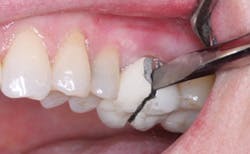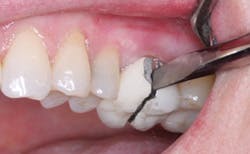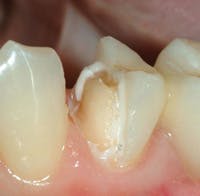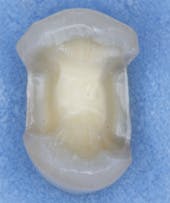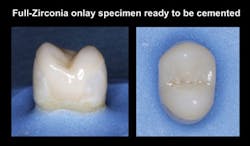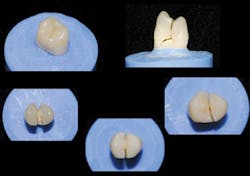Ask Dr. Christensen
Gordon J. Christensen, DDS, MSD, PhD
In this monthly feature, Dr. Gordon Christensen addresses the most frequently asked questions from Dental Economics® readers. If you would like to submit a question to Dr. Christensen, please send an email to [email protected].
Resin Veneers vs. Ceramic Veneers
Q When I suggest ceramic veneers to many of my patients, they balk at the fee. It appears that the recession has caused a visible reluctance in patients to accept elective procedures that they often accepted before the recession. What can I do to overcome this challenge?
A Your question is a common one since the recession started a few years ago. Many patients are unwilling to accept treatment because they’re reluctant to spend their discretionary money. Before the recession, a significant percentage of the indirect restorations placed in the U.S. were ceramic veneers. I’ve been told by some of the major U.S. laboratories that since the depth of the recession, the percentage of indirect veneers being accomplished has dropped to a minimal level. You or I are not going to be capable of influencing patients toward ceramic veneers or any other relatively expensive elective treatment unless they are still financially stable and affluent.
Many years ago, about the time that resin-based composite became a viable and reliable material, I started placing resin as veneers. My peers criticized me for placing what they thought was a relatively “temporary” material as a veneer, but I was convinced that resin would be one of the acceptable materials for veneers. I was right! Some of those resin veneers placed with microfill resin are still in the mouth today, 30 years later (Figs. 1, 2). However, veneers that were placed with larger particle size filler materials soon became rough and had to be replaced.
The ceramic veneers were introduced in the mid-’80s, and their success and relative ease of placement soon made resin veneers less popular.
As you stated, patients are currently not eager to spend a significant amount of money on elective items. American Dental Association fee surveys show that the current average fee for resin-based composite veneers is about one-third of the cost of ceramic veneers. Is now the time to revive resin veneers? In my opinion, yes!
Resin materials have improved markedly over the past several decades. The major improvement has been refinements in the filler content of the microhybrid and nanohybrid composites (those containing both silicon dioxide and small particles of glass). These refinements allow retention of surface smoothness discernible to the naked eye over an extended period of time. Additionally, some of the silicon dioxide filled microfill resins are still available. They are well known to serve adequately with a very smooth surface for a moderate period of time.
Can you place resin-based composite veneers and have a reasonable revenue production, thus making them a viable procedure from a financial standpoint? Consider the following points:
- Direct resin veneers do not have a laboratory bill.
- Direct resin veneers require only one appointment, not two.
This significantly reduces the cost of placing the veneers. Most general dentists are highly competent when working with resin, so the adaptation of their skills to resin veneers is not difficult. The only remaining challenge is learning how to place the resin veneers in a period of time that makes the technique financially feasible for your practice.
I’ve placed many direct veneers over several decades, and I’ve developed a procedure that, when learned well and incorporated into practice, can both please patients and provide adequate practice revenue. Here’s a summary of the procedure:
Steps in placing direct resin-based veneers
- Select a material that retains its smoothness over time (Fig. 3). Examples of some materials well known to retain smoothness include Durafill from Heraeus (microfill); Estelite Sigma Quick from Tokuyama (filled with small 200 nm spheres); Filtek Supreme Ultra from 3M ESPE (nanofill); Herculite Ultra from Kerr (nanohybrid); and Renamel Microfill from Cosmedent (microfill). Durafill, Renamel Microfill, and Estelite actually get smoother over service time in the mouth, supposedly related to the continued smoothing effect of using toothpaste on the resins with extremely small size filler particles. Filtek Supreme Ultra and Herculite Ultra start out extremely smooth at placement and finishing, and then get slightly microscopically roughened over a service period, which is not observable to the naked eye. Any of these products as well as some others will remain smooth over a service period (Fig. 4).
- Anesthetize the patient. This is primarily to avoid discomfort when placing tissue-packing cord.
- Place nonchemical impregnated retraction cord under the facial gingival margins to push the gingiva about 1 mm apically. Styptics or vasoconstrictors are not needed if you do not injure the soft tissue.
- Accomplish the tooth preparation to provide homogeneous contours of the teeth being veneered. Some malpositioned teeth may require more facial reduction than those teeth in acceptable positioning (Fig. 5).
- One tooth at a time, place Mylar strips, running from mesial to lingual to distal, to provide separation from adjacent teeth and to form a confined contour for the resin material from the epithelial attachment on the mesial to the epithelial attachment on the distal.
- Place one bulk piece of resin on one tooth at a time. This bulk should be judged to be an amount adequate for the entire veneer. Using smaller increments tends to create folds and lines in the resin.
- Using a flat, thin, large instrument (Microfill Placement Instrument from Almore), contour the resin to approximately the correct facial and proximal anatomy.
- Cure the resin one tooth at a time. At this time, the resin will be bulky and somewhat over-contoured.
- Interproximal initial contouring. Contour the mesial and distal interproximal surfaces to allow placement of resin on the adjacent teeth with proper contour.
- Continue individual tooth resin placement until all the teeth that are planned to be veneered have a veneer on them.
- Finish the cervical margins first. Use a Zekrya Gingival Protector from Maillefer and a #7901 12-bladed finishing bur to contour the gingival anatomy. Remove the packing cords from each tooth as you finish it. Bleeding will occur, but it will subside by the time you’ve done the remainder of the finishing.
- Finish the interproximal and facial surfaces to proper anatomy. Use the disks and strips of your choice. Good examples are GC New Metal strips, Cosmedent FlexiStrips, Sof-Lex disks from 3M ESPE, and Microfill Finishing Disks from E.C. Moore.
- Finish the incisal and occluding surfaces to desired length and occlusion.
- Polish the restorations in the same way that you finish and polish conventional composite restorations.
Resin veneers placed in the manner described are relatively easy, can be accomplished in a reasonable amount of time, and are very pleasing to patients (Fig. 6). Instructions to patients should include that the veneers will serve for several to many years depending on how well they care for them and how well they avoid hard and abrasive foods. They should also be told that stains occasionally occur on some of the margins. A dentist can remove the stains with simple disking and stripping.
We recently produced a DVD called “Direct Resin Veneers” (Item #V1559) that shows step-by-step the entire procedure discussed above, as well as the instruments and materials needed. It also demonstrates examples of direct resin veneers that have served for many years. For more information, contact us at 800-223-6569, or visit our website www.pccdental.com.
Summary
I have indirectly answered your question. Direct resin veneers serve well. They are far less expensive than ceramic veneers. Most dentists can master placement of resin veneers. A patient can have six anterior veneers for the cost of about two ceramic veneers. In other words, you now have the ability to treat those patients who did not accept ceramic veneers because of financial concerns.
Gordon Christensen, DDS, MSD, PhD, is a practicing prosthodontist in Provo, Utah. He is the founder and director of Practical Clinical Courses, an international continuing-education organization initiated in 1981 for dental professionals. Dr. Christensen is a cofounder (with his wife, Dr. Rella Christensen) and CEO of CLINICIANS REPORT (formerly Clinical Research Associates).
Past DE Issues
